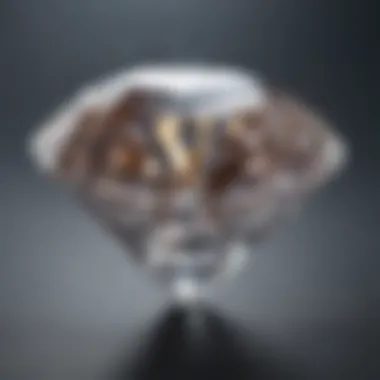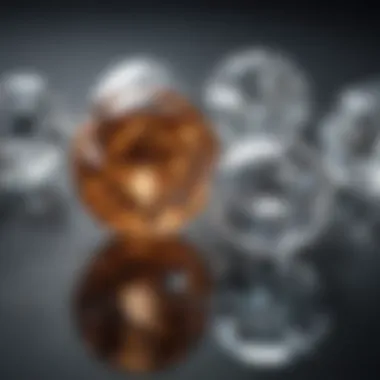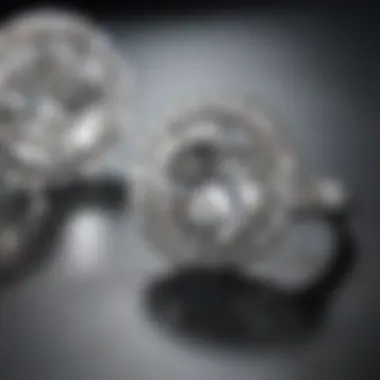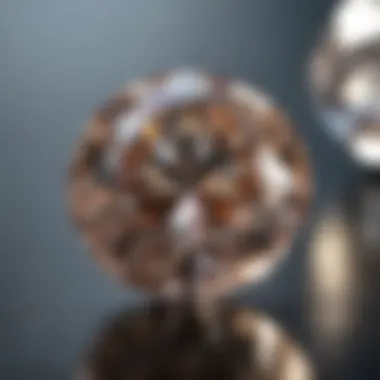Exploring Second-Hand Lab-Grown Diamonds: Market Insights


Intro
The landscape of gemstones is intricate, with a growing emphasis on sustainability shaping consumer choices. Among these gemstones, lab-grown diamonds, especially those available in the second-hand market, have gained remarkable attention. This article aims to unravel the complexities involved in purchasing second-hand lab-grown diamonds while providing a comprehensive understanding of their significance in the current market.
Lab-grown diamonds offer an alternative to natural diamonds, appealing to a segment of buyers seeking ethical and sustainable options. The second-hand market for these synthetic stones presents unique dynamics. As consumers increasingly prioritize environmental and ethical considerations in their purchasing decisions, understanding the value and implications of second-hand lab-grown diamonds becomes crucial.
In this article, we will explore various aspects related to second-hand lab-grown diamonds, ranging from their composition to market trends and ethical implications in the marketplace. Through a thorough examination, readers will gain insights on how to evaluate quality, navigate pricing, and make informed decisions for a purchase that aligns with sustainable luxury.
Understanding Lab-Grown Diamonds
Understanding lab-grown diamonds is pivotal in grasping the broader implications they hold in today's market and their valuation. These gemstones not only present an alternative to natural diamonds, but they also invite a discourse on sustainability, ethics, and consumer preferences. As lab-grown diamonds gain traction among consumers, it becomes essential to know what sets them apart from their natural counterparts. This section will explore the core aspects of lab-grown diamonds, including their definition, formation processes, and how they compare with natural diamonds.
Defining Lab-Grown Diamonds
Lab-grown diamonds are real diamonds created in controlled environments using advanced technological processes. These diamonds have the same physical and chemical properties as natural diamonds, which means they possess the same hardness, brilliance, and beauty. However, what distinguishes them is their origin; they are produced in laboratories instead of forming naturally in the earth over millions of years. This key distinction allows for greater control over purity and quality.
Formation Processes
The formation of lab-grown diamonds occurs primarily through two methods: High Pressure High Temperature (HPHT) and Chemical Vapor Deposition (CVD). Each method has unique characteristics and benefits, contributing to the broader topic of lab-grown diamonds.
High Pressure High Temperature
High Pressure High Temperature is a method that mimics the natural processes that produce diamonds. In this process, carbon is subjected to intense heat and pressure, resulting in the crystallization into diamond form. This method ensures the diamond's structure is akin to that of natural diamonds. The key characteristic of HPHT diamonds is their potential to exhibit unique inclusions that are reminiscent of natural diamonds.
The unique feature of the HPHT process is its ability to produce diamonds that are not only visually appealing but also structurally robust. One advantage is the potential to create colored diamonds through specific treatments, which adds to their market appeal. However, one drawback is the environment required; the process demands high levels of energy and precise conditions.
Chemical Vapor Deposition
Chemical Vapor Deposition involves a completely different approach by using gaseous carbon sources. In this technique, diamond seeds are placed in a vacuum chamber. Then, a carbon-containing gas is introduced. The carbon atoms settle on the seed, allowing layers to build up and grow into diamonds. The key characteristic here is that CVD diamonds can be created with fewer impurities relative to natural diamonds.
The unique feature of CVD is its adaptability; it allows for more innovative designs and customizations in diamond creation. An advantage of this method is that it can be more cost-effective over time compared to HPHT. However, one disadvantage can be the potential for differing growth patterns, which may lead to variances in quality and clarity.
Comparison with Natural Diamonds
Chemical and Physical Properties
Lab-grown diamonds share the same chemical and physical properties as natural diamonds. The hardness, refractive index, and crystal structure are all identical. This equivalence is essential for potential buyers who seek similar qualities found in natural diamonds. The characteristic brilliance, which is often the main feature for purchasing decisions, is fully retained in lab-grown diamonds.
Buyers often choose lab-grown diamonds for this precise reason. They understand they are not compromising on quality when opting for a lab-grown variant over a natural one. Additionally, the inherent advantages come without the moral queries often tied to mined diamonds, enhancing their attractiveness in the market.
Cost Differences
The cost differences between lab-grown and natural diamonds are significant and can sway buyer decisions. Typically, lab-grown diamonds are priced 20 to 40 percent less than natural diamonds of equivalent quality. This cost efficiency appeals to budget-conscious consumers, while still fulfilling their desires for high-quality gemstones.
This pricing structure allows consumers to purchase a larger or higher-quality diamond for the same budget that would be allocated for a smaller or lower-quality natural diamond. Thus, the cost-related benefits solidify the growing preference for lab-grown diamonds in the marketplace.
Lab-grown diamonds offer the same beauty at a fraction of the cost, making them an attractive option for modern consumers.
Market Dynamics of Second-Hand Diamonds
The market dynamics of second-hand diamonds play a critical role in understanding their value, accessibility, and appeal in today’s jewelry landscape. These dynamics are shaped by various elements including consumer behavior, pricing strategies, and market trends. As more individuals opt for sustainability and value, second-hand lab-grown diamonds provide a compelling alternative. This segment examines the nuances of the current market landscape, focusing on trends, customer preferences, and situational impacts.


Current Trends
Recent years have witnessed notable trends in the second-hand segment of lab-grown diamonds. The rising awareness around sustainability and ethical sourcing has influenced purchasing decisions. With lab-grown diamonds gaining recognition, their second-hand market is thriving as consumers seek to make informed choices. Emerging online platforms make it easier for sellers and buyers to connect, fundamentally changing how transactions are made. Seasonal sales and promotions can also influence the market, creating spikes in demand and interest.
Consumer Preferences
Understanding consumer preferences is essential in analyzing the second-hand market for lab-grown diamonds. Shifts in what buyers value can dictate market movements.
Sustainable Choices
Sustainable choices are increasingly appealing to buyers looking for alternatives to traditional options. The key characteristic of sustainable choices rests in their reduced environmental impact compared to mined diamonds. This aspect holds considerable weight as consumers seek to align their purchases with ecological consciousness. By opting for second-hand lab-grown diamonds, buyers can minimize waste and promote a circular economy. Additionally, environmentally-aware consumers recognize the benefits of these choices, fostering a desire for responsible consumption in their jewelry purchases.
Affordability
Affordability is another significant factor driving interest in second-hand lab-grown diamonds. These products often come at a lower price point compared to brand-new diamonds, attracting a wider audience. The key characteristic of affordability lies in the substantial savings buyers can achieve. This aspect makes second-hand options particularly attractive for young couples or those looking to invest in quality without overspending. However, buyers must consider the possibility that prices might vary widely based on condition and market demand. Overall, the affordability of second-hand lab-grown diamonds creates accessible entry points for many potential buyers.
Impact of COVID-19
The COVID-19 pandemic has reshaped the market for second-hand diamonds in profound ways. A surge in online shopping during lockdowns prioritized digital transactions, leading consumers to explore second-hand options with greater enthusiasm. This shift has heightened awareness of sustainable choices, as many individuals sought out ethical and affordable alternatives during uncertain economic times.
The continuing health crisis also prompted individuals to reassess their priorities, with investments in meaningful purchases gaining precedence. Thus, second-hand lab-grown diamonds have carved a substantial niche, appealing to consumers craving both value and significance in their jewelry selections.
"The second-hand market for lab-grown diamonds showcases a fusion of sustainability and affordability, aligning well with contemporary buyer values."
In summary, the market dynamics of second-hand lab-grown diamonds reflect broader shifts in consumer behavior and societal values. The growing emphasis on sustainability and cost-effectiveness ensures these gems remain a relevant and valuable choice for discerning buyers.
The Value Proposition of Second-Hand Lab-Grown Diamonds
The discussion surrounding second-hand lab-grown diamonds is becoming increasingly relevant in today's marketplace. These diamonds offer a compelling combination of sustainability, ethical considerations, and value. As consumers become more aware of their purchasing decisions and the impact on the environment, the appeal of second-hand lab-grown diamonds grows. This segment addresses crucial aspects such as valuation criteria, the dynamics of depreciation versus appreciation, and market comparisons. By delving into these areas, we can appreciate the unique standing that second-hand lab-grown diamonds hold in the broader context of luxury goods.
Criteria for Valuation
Valuation of second-hand lab-grown diamonds hinges on specific criteria. Key elements include cut, color, clarity, and carat weight.
Cut, Color, Clarity, Carat
The cut of a diamond greatly influences its brilliance and overall appeal. For instance, a well-cut diamond may exhibit superior light performance, making it more desirable. Color refers to the absence of color in a diamond, with less color typically indicating a higher value. Clarity assesses the presence of imperfections; diamonds with fewer blemishes are prized. Carat weight relates directly to size, impacting the overall worth of the diamond.
These factors are vital in determining market price and desirability. Second-hand lab-grown diamonds can still be options of choice, given that many hold their value well, especially when they possess excellent cut and clarity.
Overall, understanding these criteria assists buyers in making informed choices and maximizing value.
Depreciation versus Appreciation
Second-hand lab-grown diamonds tend to experience different financial trajectories than natural stones. In general, diamonds have long been viewed as a store of value. However, lab-grown diamonds have distinct characteristics. They often depreciate more rapidly initially due to consumer perceptions. Yet, as acceptance grows, particularly concerning sustainability, certain diamonds can appreciate over time. The long-term value can be influenced by factors such as rarity or quality of the stone.
Market Comparisons
When assessing the value proposition, comparisons between second-hand and new diamonds are essential.
Second-Hand vs. New Diamonds
Second-hand lab-grown diamonds often present a cost-effective alternative to newly produced ones. Buyers can save a significant amount while still obtaining quality products. Many individuals appreciate the stories behind second-hand pieces, adding sentimental value. However, it's important to assess the condition and certifications when selecting second-hand rather than new.
Lab-Grown vs. Natural Diamonds


The contrast between lab-grown and natural diamonds also plays a critical role in valuations. Lab-grown diamonds typically come at a lower price point compared to natural diamonds, which hold significant market prestige. As consumers shift their focus towards ethical sourcing, lab-grown diamonds are increasingly viewed favorably. The environmental impacts associated with mining natural diamonds further enhance the appeal of lab-grown alternatives.
Both options have their place in the market, but understanding the nuances of each can significantly impact purchasing decisions.
Ultimately, the value proposition of second-hand lab-grown diamonds positions them as an attractive and responsible choice for discerning buyers.
Ethical and Environmental Considerations
The conversation surrounding second-hand lab-grown diamonds inevitably leads to a discussion on ethical and environmental considerations. As consumers increasingly prioritize sustainability and ethical sourcing, understanding these elements becomes crucial. The choices individuals make when purchasing diamonds reflect broader societal values. Lab-grown diamonds already offer an environmentally friendly alternative to traditional mining. By considering their second-hand value, buyers contribute further to sustainability and ethical consumption in the luxury market.
Sustainability Aspects
Sustainability is at the heart of the lab-grown diamond industry. These diamonds are produced using technology that generally requires less land, water, and energy compared to mined diamonds. Importantly, the production process involves minimal disruption to ecosystems. When it comes to second-hand diamonds, the environmental benefits continue. Reusing and repurposing diamonds means less demand for new production, which helps to reduce carbon footprints further. Furthermore, opting for second-hand options minimizes waste, aligning individual choices with global sustainability goals.
Ethical Consumerism
Ethical consumerism is becoming a driving force in many markets, including luxury goods like diamonds. The growth of the lab-grown diamond industry responds to consumer demand for products with transparent, ethical supply chains. Purchasing second-hand lab-grown diamonds not only embodies this ethical commitment but also supports a circular economy. Consumers are empowered to choose diamonds that do not fund conflict or exploitative labor practices. This shift is significant; making informed choices fosters accountability among producers and encourages responsible practices industry-wide.
Regulations and Standards
Navigating the realms of ethics and sustainability within the diamond market also involves understanding regulations and standards. Various certifications exist to guarantee the authenticity of lab-grown diamonds. The International Gemological Institute (IGI) and the Gemological Institute of America (GIA) offer grading reports that verify the quality and source of diamonds. Buyers should be aware of these standards to make informed purchasing decisions. Adequate regulations not only provide reassurance but also elevate the trustworthiness of the entire market. As consumers advocate for ethical practices, increased scrutiny and transparency will likely shape future regulations, encouraging higher standards across the industry.
"Consumers are empowered to choose diamonds that do not fund conflict or exploitative labor practices."
By delving into these considerations, buyers of second-hand lab-grown diamonds not only engage in responsible shopping but also contribute positively to the environment and society. The growing recognition of ethical and environmental factors in purchasing decisions signifies a meaningfully evolving luxury market.
Navigating the Second-Hand Market
Understanding how to navigate the second-hand market for lab-grown diamonds is essential for potential buyers. This segment not only informs consumers about where to purchase these gems but also guides them on how to assess their authenticity and value. With the rising popularity of sustainable luxury, taking the right steps in the second-hand market can lead to rewarding experiences for buyers.
Where to Buy
Online Retailers
Online retailers are pivotal in the second-hand diamond market. They offer a contnuum of options, making it easier for consumers to find the specific gem they want. A significant advantage of online shopping is convenience. Buyers can explore a wide selection from the comfort of their homes. Online platforms often provide detailed descriptions and images, helping buyers to gauge quality before making a decision. However, it's crucial to pick reputable websites to reduce risks of fraud.
Auction Houses
Auction houses present a different method of purchasing second-hand lab-grown diamonds. This approach appeals to buyers searching for unique or rare pieces. Auction houses can create a thrilling atmosphere of competition, potentially leading to lower prices for savvy bidders. The key characteristic here is the high level of transparency regarding the items being sold, often supported by expert appraisals. On the flip side, auction houses can have higher fees, and prices may fluctuate based on demand.
Jewelry Exchanges
Jewelry exchanges serve as a trustworthy middle ground for buying second-hand diamonds. They connect buyers and sellers in a regulated environment, ensuring that transactions are secure. The unique feature of jewelry exchanges includes the opportunity for buyers to physically inspect items before purchasing. This tactile experience can enhance buyer confidence. Nonetheless, exchanges may charge commissions on sales, which could affect pricing.
Evaluating Authenticity
Certification and Appraisal
When in the market for second-hand lab-grown diamonds, certification and appraisal are vital. These processes provide an official assessment of a diamond's quality and authenticity. Having a certified gem ensures that its value is secured by established standards. Certification is popular among buyers seeking reassurance about their purchases. However, not all appraisal services are equal; some may not carry the same credibility.
Return Policies
Return policies significantly influence consumer confidence in the second-hand market. A flexible return policy allows buyers to feel secure in their decision, knowing they can return the item if it doesn't meet their expectations. Retailers with clear and reasonable return timelines are often seen as more trustworthy. Yet, stringent or unclear return policies can deter potential buyers.


Tips for Buyers
Researching Sellers
Researching sellers is crucial in the second-hand diamond market. A reliable seller should have a known track record and positive reviews. Understanding seller credibility provides assurance that the transaction will be fair and transparent. Exploring both online and offline reviews can unveil necessary insights. Consideration of sellers’ reputation will ultimately guide buyers toward quality over quantity.
Understanding Return Options
Understanding return options is also an important consideration. Buyers need to familiarize themselves with the specific terms and conditions set forth by the seller. By knowing the return process in advance, buyers can protect themselves from possible dissatisfaction. This understanding can also help buyers make informed decisions about their purchases.
Navigating the second-hand market for lab-grown diamonds entails careful research and due diligence. With the appropriate knowledge, consumers can confidently partake in this evolving segment of the market.
Future of Lab-Grown Diamonds
In the realm of gemstones, lab-grown diamonds represent a pivotal evolution. The future of these diamonds is not only notable for the advancements in their production but also for the market dynamics that accompany them. As consumers become increasingly conscientious about environmental impacts and ethical sourcing, the appeal of lab-grown diamonds continues to grow. This section discusses technological advancements, projected market growth, and shifting cultural perceptions surrounding lab-grown diamonds.
Technological Advancements
Technological advancements have played a significant role in the evolution of lab-grown diamonds. The processes of High Pressure High Temperature (HPHT) and Chemical Vapor Deposition (CVD) have been refined over recent years. These methods have improved the quality of lab-grown diamonds, enabling them to closely mirror the brilliance and physical properties of their natural counterparts.
Furthermore, innovations in techniques have led to faster production cycles and increased volume of diamonds available at competitive prices. This enhanced efficiency not only lowers consumer costs but also makes lab-grown diamonds more accessible to a broader audience.
The combination of technology and research ensures that future products will likely boast even higher quality, further boosting consumer interest.
Projected Market Growth
The market for lab-grown diamonds is projected to experience considerable growth in the coming years. Analysts predict that the demand for these diamonds will rise as awareness increases among consumers. This is partly due to the intricate relationship between sustainability and consumer purchasing behavior. As reported by various market research firms, the expected compound annual growth rate (CAGR) for lab-grown diamonds is significantly higher than that of natural diamonds.
The proliferation of both online platforms and traditional retail outlets means that consumers will have more choices. Increasing presence in high-end jewelry stores indicates a solidified position in the market. Moreover, collaborations between established luxury brands and lab-grown diamond retailers will enhance visibility and consumer trust.
Shifting Cultural Perception
Cultural perception towards lab-grown diamonds is shifting. Once seen as inferior to natural diamonds, lab-grown alternatives are gaining recognition for their quality, value, and ethical production processes. Educational campaigns highlighting the environmental and ethical benefits play a crucial role in this perception change. Consumers are increasingly looking to purchase items that align with their values, especially regarding sustainability.
This new mindset does not only encompass millennial consumers but also older generations who are becoming more informed about the ethical implications of diamond sourcing.
"As we move toward a more aware consumer base, lab-grown diamonds may dominate the market, reflecting values that resonate with modern sensibilities."
Closure
The conclusion serves as an essential part of this article, summarizing the complex interplay between second-hand lab-grown diamonds and the contemporary market. Understanding this relationship is vital for anyone engaged in the trade or collection of these gems.
Summary of Insights
In our exploration of second-hand lab-grown diamonds, we have covered various dimensions, from their formation processes to their value proposition in the market. The composition of these diamonds, realized through advanced technology, sets them apart from their natural counterparts. The criteria for valuation – cut, color, clarity, and carat – emerge as fundamental in determining worth in the second-hand market.
Moreover, ethical considerations loom large. Consumers today are increasingly aware of their choices. They look for sustainable options that reflect their values. Thus, the market for second-hand lab-grown diamonds is strengthened by these ethical concerns. Sustainability resonates deeply, appealing to individuals looking to balance luxury with responsibility.
The nuances of market dynamics reveal changing consumer preferences. The impacts of recent global events like COVID-19 have also played a role, altering buying behaviors and priorities. This adaptive market response indicates an underlying resilience inherent to lab-grown diamonds in a broader economic landscape.
Final Thoughts on Market Dynamics
As we conclude, it is evident that the market for second-hand lab-grown diamonds continues to evolve. The projected growth, driven by technological advancements and shifting cultural perceptions, suggests a promising future. Potential buyers should approach this market with a discerning eye, equipped with knowledge of how to evaluate quality and authenticity.
The value of second-hand lab-grown diamonds cannot be overstated. They offer an intersection of luxury, ethical considerations, and sustainable practices. This unique positioning enriches the narrative around gemstones and enhances their appeal to modern consumers seeking both beauty and purpose in their purchases.
"Second-hand lab-grown diamonds embody a commitment to sustainability without compromising on elegance."
Ultimately, as buyers navigate this growing segment of the jewelry market, staying informed and aware will lead to more thoughtful purchasing decisions. This understanding not only benefits individual consumers but also contributes to the broader dialogue around ethical luxury.







